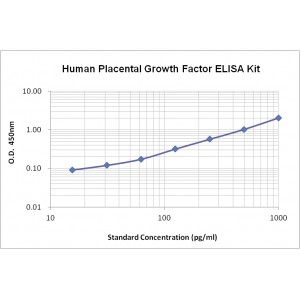More info
|
Assay Range |
15.6-1,000 pg/mL |
|
Sensitivity |
1.0 pg/mL |
|
Size |
96T |
|
Storage |
Store at 2 - 8ºC. Keep reconstituted standard and detection Ab at -20 ºC |
|
Assay Principle |
Sandwich ELISA |
|
Sample Volume |
100 µL final volume, dilution factor varies on samples |
|
Detection Method |
Chromogenic |
Kit Components
1. Recombinant Human PLGF standard: 2 vials
2. One 96-well plate coated with anti- Human PLGF Ab
3. Sample diluent buffer: 12 mL - 1
4. Detection antibody: 130 µL, dilution 1:100
5. Streptavidin-HRP: 130 µL, dilution 1:100
6. Antibody diluent buffer: 12 mL x1
7. Streptavidin-HRP diluent buffer: 12 mL x1
8. TMB developing agent: 10 mL x1
9. Stop solution: 10 mL x1
10. Washing solution (20x): 25 mL x1
Background
Placenta Growth Factor (PlGF) is a member of the Vascular Endothelial Growth Factor (VEGF) family which plays important roles in the development and/or growth of the vascular or lymphatic endothelia. The PlGF cDNA encodes a 149 amino acid (aa) mature protein containing a PDGF-like domain with 8 conserved cysteine residues. PlGF is approximately 42% aa identical to VEGF. At least 4 alternatively spliced forms: PlGF-1, PlGF-2, PlGF-3, and PlGF-4 have been identified so far. Notably, there is a heparin-binding domain in PlGF-2 and PlGF-4 which is distinct from other PIGF isoforms and may affect affinities for PlGF receptors. In mice, only the PlGF-2 ortholog has been described and it shares 65% aa identity with its human counterpart. PIGF is primarily expressed in placenta under normal conditions. Expression of PIGF is also found in microvascular and umbilical vein endothelia, bone marrow, uterine natural killer cells, and keratinocytes. In addition, it is induced by certain pathological conditions including wound healing and tumor formation.
PIGF binds to VEGF R1 (soluble and transmembrane forms), Neuropilin-1, and Neuropilin-2 to activate a series of cellular processes. It is reported that PIGF can enhance the survival, growth, and migration of endothelial cells in vitro, and promote vessel formation in certain in vivo model systems. PlGF can synergistically enhance VEGF-induced angiogenesis and vascular permeability.


